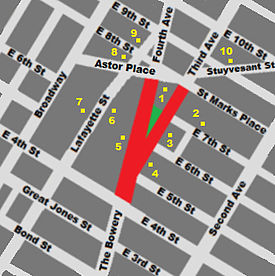BY LINCOLN ANDERSON | The Cooper Square Mutual Housing Association, a low-income housing provider, has scheduled about 280 co-op closings in 21 buildings during the first two weeks of December, comprising more than 80 percent of the association’s 327 apartments.
“Tenants are buying shares in the M.H.A. for the jaw-dropping amount of just $250 each,” said Val Orselli, the M.H.A.’s executive director. “We’ve averaged about 60 closings per day so far.”
On Oct. 4, the state Attorney General’s Office declared the precedent-setting mutual housing association’s multi-building co-op conversion plan effective, meaning the nonprofit organization could begin selling shares to the 327 low-income apartments in the scattered-site cooperative.
“This has been a very long-term project, more than 50 years actually,” said Frances Goldin, co-founder of the Cooper Square Committee, who has been involved in the process since it began. “In 1959, Robert Moses had designated a 12-block area from Ninth St. to Delancey St. as the Cooper Square Urban Renewal Area, and hundreds of buildings were to be taken through eminent domain, and slated for demolition in order to build middle-income housing. We formed the Cooper Square Committee to fight the plan. We held rallies, demonstrations, testified at hearings and some of us even got arrested, and we created our own community-based alternative plan, and ultimately we won,” Goldin said.
The city acquired dozens of buildings in the renewal area in the 1970s, but plans for renovation and new buildings stalled in the fiscal crisis.
All of the buildings required major renovation, since they were old-law tenements. Many had French tubs in the kitchen and shared bathrooms in hallways.
In 1990, the Cooper Square Committee signed a memorandum of understanding with the Dinkins administration, pursuant to a revised urban renewal plan that called for renovating the residential buildings, most of which are on E. Third and Fourth Sts. These would be transferred to a nonprofit housing company formed by Cooper Square Committee, and ultimately become low-income co-ops.
The committee formed the M.H.A. in 1991 and it began managing 21 of the city-owned buildings. Renovations began in 1991, and the last building was finally completed four years ago.
“We were not permitted to convert the buildings to a cooperative until they were all renovated,” Orselli said.
Non-purchasers’ apartments will either be rent-stabilized or if not rent-stabilized under law will still have their rents determined by the Rent Guidelines Board increases.
“When the Cooper Square Committee created the M.H.A. in 1991, the community was already gentrifying,” said Steve Herrick, the committee’s executive director. “We didn’t want to have the buildings go into the Tenant Interim Lease (TIL) program or some other alternative management program that would have only a 25-year regulatory agreement, and end up becoming market-rate housing. So we researched other affordable housing models, and we borrowed the M.H.A. model from Northern Europe. This is the first mutual housing cooperative in New York State.”
Shareholders won’t be able to make significant profits off their units. Resale prices are limited to the original purchase price — $250 for insider purchasers and $1,800 for outside purchasers, adjusted for inflation — plus any board-approved improvements. Shares must be sold back to the M.H.A., which will transfer them to approved buyers.
“These apartments are going to be a source of affordable housing for future generations of working-class New Yorkers,” said Maxine Fee, the M.H.A.’s chairperson.


















